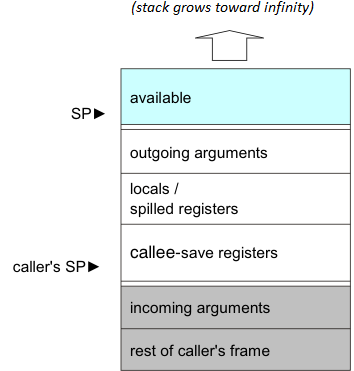SPRAC71B February 2019 – October 2023
- 1
- 1 Introduction
- 2 Data Representation
-
3 Calling Conventions
- 3.1 Call and Return
- 3.2 Register Conventions
- 3.3 Argument Passing
- 3.4 Return Values
- 3.5 Structures and Unions Passed and Returned by Reference
- 3.6 Conventions for Compiler Helper Functions
- 3.7 Prolog and Epilog Helper Functions
- 3.8 Scratch Registers for Functions Already Seen
- 3.9 Interrupt Functions
- 4 Data Allocation and Addressing
- 5 Code Allocation and Addressing
- 6 Helper Function API
-
7 Standard C Library API
- 7.1 About Standard C Libraries
- 7.2 Reserved Symbols
- 7.3 <assert.h> Implementation
- 7.4 <complex.h> Implementation
- 7.5 <ctype.h> Implementation
- 7.6 <errno.h> Implementation
- 7.7 <float.h> Implementation
- 7.8 <inttypes.h> Implementation
- 7.9 <iso646.h> Implementation
- 7.10 <limits.h> Implementation
- 7.11 <locale.h> Implementation
- 7.12 <math.h> Implementation
- 7.13 <setjmp.h> Implementation
- 7.14 <signal.h> Implementation
- 7.15 <stdarg.h> Implementation
- 7.16 <stdbool.h> Implementation
- 7.17 <stddef.h> Implementation
- 7.18 <stdint.h> Implementation
- 7.19 <stdio.h> Implementation
- 7.20 <stdlib.h> Implementation
- 7.21 <string.h> Implementation
- 7.22 <tgmath.h> Implementation
- 7.23 <time.h> Implementation
- 7.24 <wchar.h> Implementation
- 7.25 <wctype.h> Implementation
-
8 C++ ABI
- 8.1 Limits (GC++ABI 1.2)
- 8.2 Export Template (GC++ABI 1.4.2)
- 8.3 Data Layout (GC++ABI Chapter 2)
- 8.4 Initialization Guard Variables (GC++ABI 2.8)
- 8.5 Constructor Return Value (GC++ABI 3.1.5)
- 8.6 One-Time Construction API (GC++ABI 3.3.2)
- 8.7 Controlling Object Construction Order (GC++ ABI 3.3.4)
- 8.8 Demangler API (GC++ABI 3.4)
- 8.9 Static Data (GC++ ABI 5.2.2)
- 8.10 Virtual Tables and the Key function (GC++ABI 5.2.3)
- 8.11 Unwind Table Location (GC++ABI 5.3)
-
9 Exception Handling
- 9.1 Overview
- 9.2 PREL31 Encoding
- 9.3 The Exception Index Table (EXIDX)
- 9.4 The Exception Handling Instruction Table (EXTAB)
- 9.5 Unwinding Instructions
- 9.6 Descriptors
- 9.7 Special Sections
- 9.8 Interaction With Non-C++ Code
- 9.9 Interaction With System Features
- 9.10 Assembly Language Operators in the TI Toolchain
- 10DWARF
- 11ELF Object Files (Processor Supplement)
- 12ELF Program Loading and Linking (Processor Supplement)
- 13Build Attributes
- 14Copy Tables and Variable Initialization
- 15Revision History
4.6 Frame Layout
There are at least two cases that require a standardized layout for the local frame and ordering of callee-saved registers. They are exception handling and debugging.
This section describes conventions for managing the stack, the general layout of the frame, and the layout of the callee-saved area.
The stack grows from zero toward higher addresses. The SP points to the next unused memory location.
Objects in the frame are accessed using SP-relative addressing with positive offsets.
A compiler is free to allocate one or more "frame pointer" registers to access the frame. The TI compiler does not use a frame pointer, so a single call frame is limited to 0xffff bytes.
Insofar as a frame pointer is not part of the linkage between functions, the choice of whether to use a frame pointer, which register to use, and where it points is up to the discretion of the toolchain. However, the exception handling stack unwinding instructions assume that no frame pointer is available.
The stack frame of a function contains the following areas:
- Incoming arguments that are passed on the stack are part of the caller's frame.
- The callee-saved area stores registers modified by the function that must be preserved. If exceptions or debugging is enabled, a specific layout must be adhered to. If not, a compiler is free to use alternative schemes for saving registers.
- The locals and spill temps area consists of temporary storage used by the function.
- The outgoing arguments section is for passing non-register arguments to called functions, as detailed in Section 3.3. The size of the section is the maximum required for any single call.
 Figure 4-2 Local Frame Layout
Figure 4-2 Local Frame LayoutBefore the frame is allocated, SP points to the return address (SR for interrupt functions).